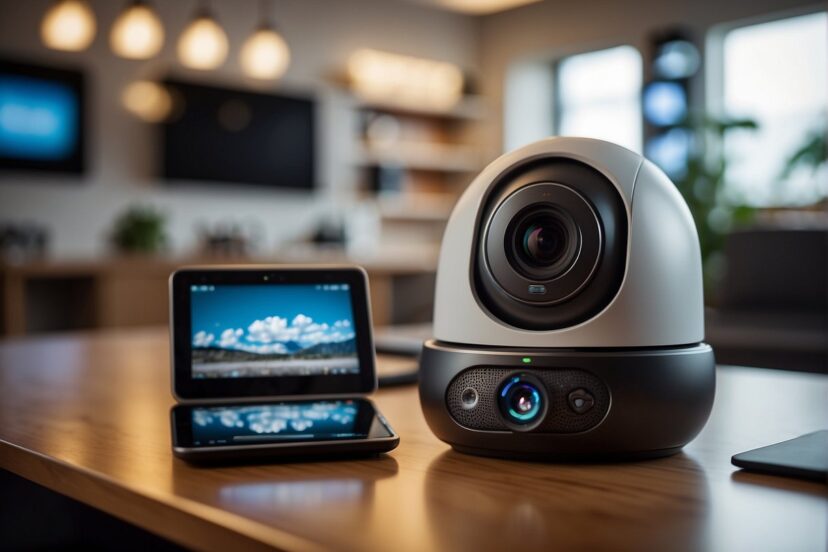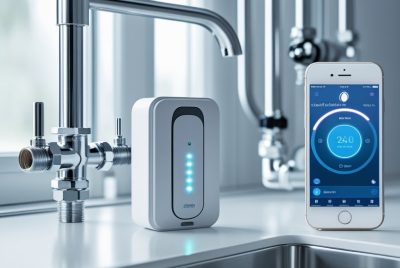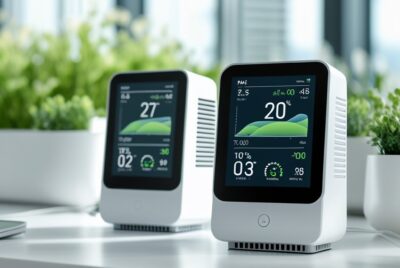WiFi Smart Net Camera Review: Unveiling the Features
*We may earn a commission for purchases made using our links. Please see our disclosure to learn more.
WiFi Smart Net Camera Review: Unveiling the Features and Performance
As someone who values home security and appreciates the convenience of modern technology, a wifi smart net camera represents a significant advancement in keeping homes and businesses secure. These devices connect to the internet via WiFi, allowing users to monitor their property remotely from any location with internet access. The cameras often come with a variety of features, including high-definition video recording, night vision capabilities, and motion detection alerts that can be sent directly to a smartphone or other device.

I have observed that setting up these cameras typically involves a simple process that can be completed with minimal technical know-how. Users usually need to download a corresponding app, such as V380, to facilitate the interaction between their device and the camera. The app allows for live viewing, playback of recorded footage, and the management of camera settings. The straightforward user experience and remote access provide both peace of mind and a sense of control over one’s home security.
Furthermore, I’ve noticed the integration of smart features in these cameras, such as two-way audio, which allows for real-time communication with anyone in front of the camera. Often, these smart cameras also come with a cloud storage option, ensuring that surveillance footage is safely backed up and accessible when needed. This combination of smart technology and wireless connectivity makes the wifi smart net camera an essential component in modern home security systems.
Design and Models for a WiFi Smart Net Camera

When discussing WiFi smart net cameras, design and functionality vary greatly across models and brands. My focus here is to present you with the distinctions that exist within this diverse product category.
Camera Models and Brands
I’ve observed that WiFi cameras, commonly employed for home security, are available in various designs ranging from discreet, compact models to more prominent ones with advanced features. Brands like V380 often emphasize high-quality image resolution and scalability in their models. This means you, as a consumer, can expect to find cameras that not only offer crisp visuals but also adapt to different security needs over time.
Camera Models and Brands:
| Model | Brand | Features | Ideal for |
|---|---|---|---|
| V380 | V380 | HD resolution, scalable system integration | Indoor, expanding systems |
| Not Specified | Best Buy | Varied selection with in-store pickup options | Convenience shoppers |
| Not Specified | Generic | Reviews-focused selection | Quality and reliability |
I’ve also noticed that each brand has a distinct approach to integrating their cameras with smart home systems, meaning that you’ll find differences in compatibility and control options. Keep in mind that newer models might offer more sophisticated features such as motion detection, night vision, and cloud storage options, further enhancing home security.
Installation and Setup

In setting up a WiFi Smart Net Camera, specifically the V380 or V380 Pro, the process involves ensuring a stable WiFi connection, mounting the camera properly, and configuring it via the app. I’ll guide you through connecting to your home network, mounting the camera, and configuring it with the V380 App.
Connecting to Home Network
To initiate installation, I connect the camera to a power source and ensure it’s near my WiFi router for an uncomplicated setup. Then I follow these steps:
- Turn on the camera: Wait for the auditory cue that signals it’s ready for setup.
- WiFi Connectivity: On my smartphone, I use the camera’s QR code to connect to the manufacturer’s app. It’s important to have my WiFi network credentials ready to establish a successful connection.
- Network Configuration: I select my home WiFi network and enter the password. This couples the camera with my home network, enabling remote access and control.
Mounting the Camera
Selecting a vantage point is crucial, and here’s why I’m careful:
- Field of View: I look for a broad, unobstructed view where the camera can capture as much area as possible.
- Stability: I ensure the surface is stable enough to support the camera and prevent movement that could skew footages.
Once I have found the perfect spot, I use the supplied mounting hardware to secure the camera, keeping in mind the proximity to a power source and the WiFi router for uninterrupted operation.
V380 App Configuration
With the camera mounted and connected to the WiFi, the next step is configuring it through the V380 or V380 Pro app:
- App Installation: I download the V380 app from the Apple App Store or Google Play, depending on my device.
- Camera Setup: Within the app, I add my camera. This may involve scanning the QR code on the camera or manually entering the camera’s ID.
- Customize Settings: Then, I personalize my camera’s settings, including the resolution, motion detection sensitivity, and alerts.
Using these specific steps, my V380 WiFi Smart Net Camera is up and running swiftly, reliably streaming video footage that I can access from my device anywhere, anytime.
Features and Functionality of a WiFi Smart Net Camera

In my exploration of WiFi smart net cameras, I’ve pinpointed crucial functionalities that set high-quality devices apart from basic models. These features are pivotal for anyone looking to maintain security and integration with modern smart home ecosystems.
Smart Home Integration
Smart net cameras seamlessly integrate with smart home systems, allowing for management through central hubs like Alexa. Motion detection and alerts sent directly to my phone ensure I’m always informed of any activity. This is critical for coordinating automated responses or reviewing footage.
Video and Audio Quality
My experience underscores that superior video quality is a must, with many smart cameras offering HD resolution. Night vision is another indispensable feature, permitting clear recordings in low light conditions. Good audio capture complements the visual, resulting in a comprehensive surveillance package.
Remote Access and Monitoring
Remote access via a mobile app allows me to monitor my premises from anywhere. This feature ensures my peace of mind, as I receive notifications for detected movement. The app also gives me the ability to control camera settings remotely, adding to its versatility.
Storage Options
Finally, storage must be addressed. I can store footage via local solutions like SD cards or through cloud services, which often require a subscription. The former affords me direct and quick access, while the latter offers expansive space and off-site security.
By addressing these features, such as smart home compatibility, high-caliber video and audio, remote functionalities, and varied storage, I ensure a comprehensive surveillance setup for any user’s needs.
Security Enhancements of a WiFi Smart Net Camera

In my experience with WiFi smart net cameras, I’ve found that robust security features are paramount. Taking this into account, I’ll focus on encryption practices and the protocols for security breach notifications that are in place to enhance the security of data at home.
Encryption and Data Protection
When it comes to protecting the data that my smart net camera transmits, I place my trust in advanced encryption standards. Specifically, I look for cameras that utilize transport layer security (TLS) encryption, which secures the data path between the camera and my network. This includes both the live feed and stored recordings. AES 256-bit encryption is a staple for any data at rest. Furthermore, I make sure that any camera I add to my home network features end-to-end encryption to prevent potential eavesdropping during data transmission.
It’s worth noting that the strength of the Wi-Fi security protocol plays a significant role. That’s why I always ensure that my camera supports the latest WPA3 protocol, which provides stronger password protection and enhanced Wi-Fi security.
Security Breach Notifications
One of my top criteria for a smart net camera is an effective notification system in the event of a security breach. I expect immediate alerts to my phone or email if there’s any unusual activity. The camera’s system should automatically log all access attempts and flag any unauthorized entry.
To streamline the process, I prefer cameras that integrate with home automation systems. This allows for real-time updates and the ability to potentially link the camera’s security protocols with other smart home devices for a coordinated response to any breaches. It’s essential that these notifications are both prompt and actionable, offering me the necessary details to quickly assess the situation and respond accordingly.
Technical Specifications

In my expertise with WiFi Smart Net Cameras, I’ve found that specific technical details are critical for understanding their capabilities. I’m focusing on the critical connectivity protocols and pathways that allow for effective camera feeds and control.
Connectivity Protocols
These cameras typically utilize the Internet Protocol (IP) to transmit data over a network. I have noted that the following are common protocols underpinning IP cameras:
- Wi-Fi: For wireless data transmission within a local network.
- Ethernet: For wired connections, ensuring stable data transfer.
- ONVIF: An open industry standard for interoperability of IP-based security products.
Camera Feed and Control Paths
To manage the camera feed and control settings, a direct or mediated path is established:
- Direct Access: A secured path for live feed viewing and control via web interfaces or dedicated applications.
- Cloud Services: An indirect path where camera feeds are sent to cloud servers allowing for remote access and management. This often involves:
- Live streaming capabilities.
- Storage solutions for recorded footage.
- Advanced control features, like custom alerts or motion detection parameters.
My knowledge indicates that the integrity of the camera feed and the responsiveness of controls are highly dependent on these paths and protocols.
Frequently Asked Questions
In this section, I provide answers to some of the most common inquiries about smart net cameras to ease the setup and troubleshooting process.
1. How can I set up my smart net camera on a mobile device?
I make sure to download the camera’s dedicated app from the App Store or Google Play, then follow the in-app instructions to connect the camera to my Wi-Fi network, allowing me to view the camera’s feed on my mobile device.
2. What steps are involved in installing the smart net camera for the first time?
Initially, I identify an optimal location for my camera that covers the intended area. I then power on the camera, connect it to my Wi-Fi network using the provided instructions, and configure the settings to match my security preferences.
3. How do I troubleshoot connectivity issues with my smart net camera?
I check my Wi-Fi connection’s upload speed to ensure it’s above 2 MB per second, as most cameras require a stable internet connection. I also ensure that firmware updates are not interrupted, as incomplete updates can cause issues.
4. Which app is required to operate my smart net camera, and where can I download it?
To operate my smart net camera, I need the specific app designed for it. The app name is usually provided in the user manual, and I can download it directly from the iOS App Store or Android Google Play Store.
5. What are some common issues and their solutions for smart net cameras?
Common issues include blurry video, connection dropouts, or notifications not working. For these, I ensure the camera lenses are clean, the camera is within range of my Wi-Fi router and I check the app settings to ensure notifications are turned on.




